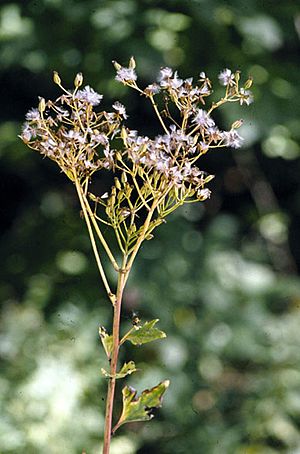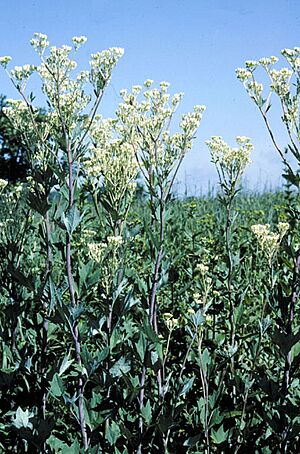Pale Indian plantain facts for kids
Quick facts for kids Pale Indian plantain |
|
|---|---|
 |
|
| Scientific classification | |
| Kingdom: | |
| (unranked): | |
| (unranked): | |
| (unranked): | |
| Order: | |
| Family: | |
| Tribe: |
Senecioneae
|
| Genus: |
Arnoglossum
|
| Species: |
A. atriplicifolium
|
| Binomial name | |
| Arnoglossum atriplicifolium (L.) H. Rob.
|
|
| Synonyms | |
|
Synonymy
Adenimesa atriplicifolia Nieuwl.
Cacalia atriplicifolia L. Cacalia gigantea Nees Cacalia paniculata Raf. Cacalia rotundifolia (Raf.) House Cacalia similis (Small) J.Buchholz & E.J.Palmer Conophora atriplicifolia (L.) Nieuwl. Conophora similis (Small) Nieuwl. Mesadenia atriplicifolia (L.) Raf. Mesadenia pulverulenta Raf. Mesadenia rotundifolia Raf. Mesadenia similis Small Senecio atriplicifolius (L.) Hook. |
|
The pale Indian plantain, also known as Arnoglossum atriplicifolium, is a wildflower found in North America. It belongs to the sunflower family. This plant grows year after year, which means it is a perennial.
You can find the pale Indian plantain across the central and eastern parts of the United States. It grows from the Atlantic Coast all the way to Kansas. However, it is an endangered plant in the state of New Jersey.
About the Pale Indian Plantain
What it Looks Like
The pale Indian plantain is a very tall plant. It can grow up to 300 centimeters (about 10 feet) high. That's taller than most people!
This plant spreads using special underground stems called rhizomes. These rhizomes help new plants grow nearby. The main stem of the plant usually does not have branches.
Its Flowers
The flowers of the pale Indian plantain are usually white. Sometimes they have a little bit of green or purple color.
These flowers have what are called disc florets. But they do not have ray florets. Ray florets are the petal-like parts you see on a typical daisy or sunflower.


